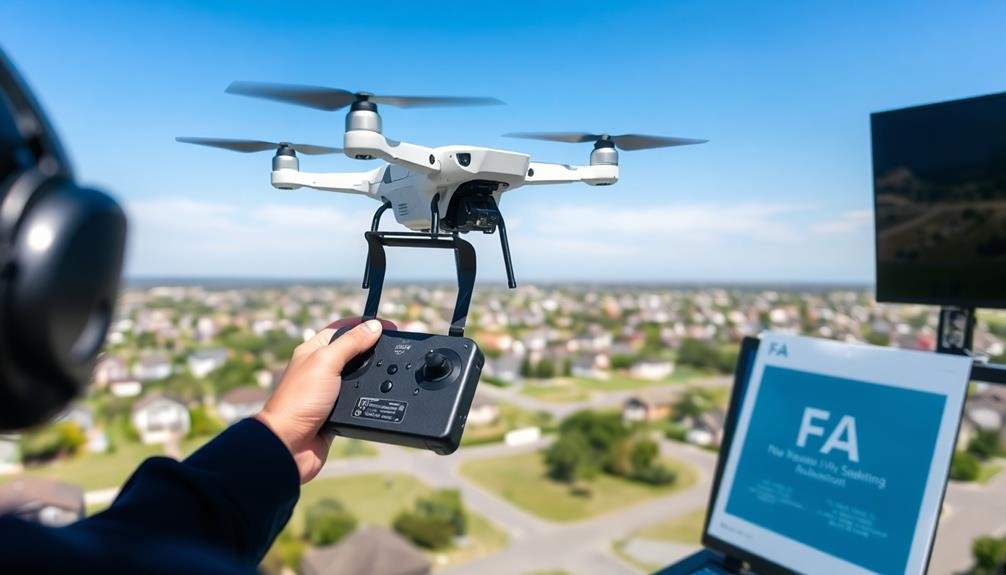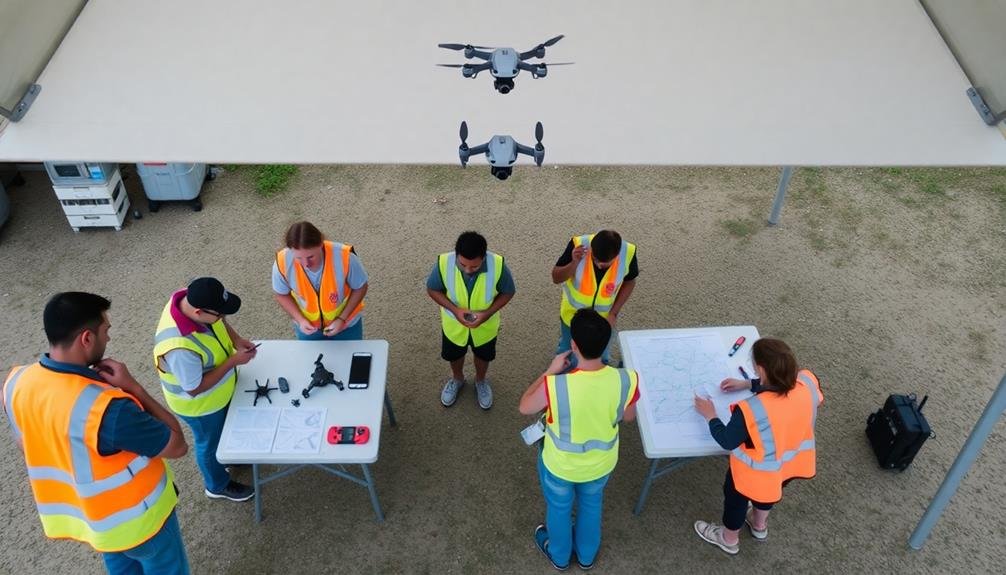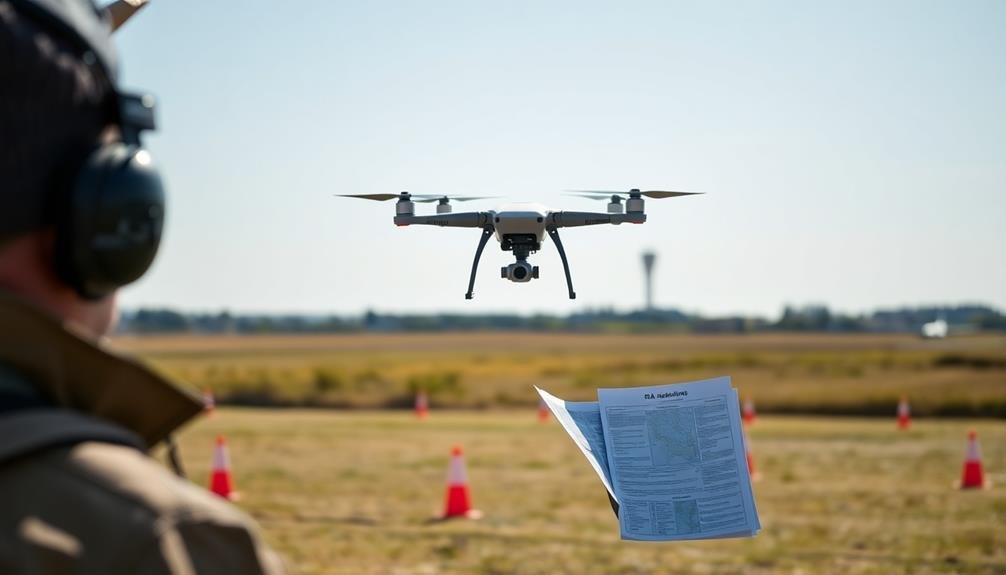To master unmanned aircraft safety rules, follow these five key steps: First, study FAA regulations thoroughly, focusing on Part 107 for commercial flying. Next, complete online training courses to gain essential knowledge on airspace, weather, and emergency procedures. Then, practice with flight simulators to hone your skills without risking actual drones. Join drone safety communities to connect with experienced operators and stay updated on regulations. Finally, attend hands-on safety workshops for practical experience and immediate expert feedback. By following these steps, you'll be well-prepared to operate drones safely and compliantly. Explore each step in detail to become a proficient and responsible unmanned aircraft pilot.
Key Takeaways
- Study FAA regulations, focusing on Part 107 rules for commercial flying and understanding no-fly zones.
- Complete online training courses, including FAA modules and specialized programs from reputable organizations.
- Practice with flight simulators to master basic skills and emergency procedures without risking actual drones.
- Join drone safety communities to learn from experienced operators and stay updated on regulations.
- Attend hands-on safety workshops to gain practical experience in drone operation and safety protocols.
Study FAA Regulations

Before you even think about flying a drone, it's crucial to familiarize yourself with the Federal Aviation Administration's (FAA) regulations. These rules are designed to guarantee the safety of both manned and unmanned aircraft operations.
Start by visiting the FAA's official website and accessing their drone-specific guidelines. You'll find information on registration requirements, airspace restrictions, and operational limitations.
Pay close attention to the Part 107 rules if you're planning to fly commercially. These regulations cover topics like pilot certification, drone weight limits, and flight altitude restrictions.
Even if you're a recreational flyer, you'll need to follow the FAA's guidelines for hobbyists.
Make sure you understand no-fly zones, such as areas near airports, military bases, and national parks. Learn about the B4UFLY app, which provides real-time information on flight restrictions in your area.
Familiarize yourself with visual line-of-sight requirements and the rules for flying at night or over people.
Stay updated on changes to FAA regulations, as drone laws evolve rapidly. Consider joining online forums or local drone groups to stay informed about new rules and best practices.
Complete Online Training Courses

Once you've grasped the FAA regulations, it's time to enhance your knowledge through online training courses. These courses offer thorough instruction on unmanned aircraft safety rules and best practices.
Start by exploring the FAA's free online training modules, which cover essential topics like airspace classifications, weather conditions, and emergency procedures.
Next, consider enrolling in specialized courses offered by reputable drone training organizations. These programs often provide in-depth coverage of specific areas, such as night operations, advanced maneuvers, or commercial applications.
Look for courses that include interactive simulations and real-world scenarios to test your decision-making skills.
Don't overlook manufacturer-specific training for your particular drone model. These courses can provide valuable insights into your aircraft's unique features and safety systems.
Additionally, seek out online forums and communities where experienced pilots share their knowledge and discuss safety concerns.
As you complete these courses, keep a log of your training hours and certifications. This documentation will be useful for future reference and may be required for certain commercial operations.
Practice With Flight Simulators

Flight simulators offer an invaluable opportunity to hone your skills without risking your actual drone. These virtual environments replicate real-world conditions, allowing you to practice various scenarios and maneuvers safely. You'll gain confidence in your piloting abilities while familiarizing yourself with drone controls and flight characteristics.
When using flight simulators, focus on mastering basic skills like takeoff, landing, and hovering. As you progress, challenge yourself with more complex tasks such as obstacle avoidance and precision flying. Many simulators offer realistic weather conditions and different drone models, helping you prepare for diverse situations you might encounter in the field.
To maximize your learning experience with flight simulators:
- Set specific goals for each practice session
- Gradually increase difficulty levels as you improve
- Practice emergency procedures and recovery techniques
- Analyze your performance and identify areas for improvement
Remember that while simulators are excellent training tools, they can't entirely replace real-world experience. Use them as a supplement to your practical training, and always follow local regulations when operating your actual drone.
Join Drone Safety Communities

Connecting with fellow drone enthusiasts can greatly enhance your safety knowledge and skills. By joining drone safety communities, you'll gain access to valuable resources, expert advice, and real-world experiences from other pilots.
Look for local drone clubs or online forums dedicated to unmanned aircraft safety. These communities often organize meetups, workshops, and group flights where you can learn from seasoned operators.
Participate actively in discussions, ask questions, and share your own experiences. You'll find that many members are enthusiastic to help newcomers understand safety protocols and best practices.
Some communities also offer mentorship programs, pairing new pilots with experienced ones for personalized guidance.
Stay updated on the latest safety regulations and industry trends through these networks. Many communities host webinars, share educational materials, and discuss recent incidents or near-misses, helping you learn from others' mistakes.
You'll also find information about local flying areas, restricted zones, and weather conditions that affect drone operations.
Attend Hands-On Safety Workshops

Hands-on safety workshops offer an invaluable opportunity to gain practical experience in drone operation and safety protocols. These workshops provide a controlled environment where you can learn from experienced instructors and practice essential skills.
You'll get to handle different types of drones, understand their components, and learn proper maintenance techniques.
During these workshops, you'll typically engage in simulated flight scenarios that mimic real-world challenges. You'll learn how to respond to emergencies, navigate obstacles, and follow airspace regulations.
These hands-on sessions also allow you to familiarize yourself with safety equipment and procedures, ensuring you're prepared for various situations.
Attending safety workshops can benefit you in several ways:
- Enhances your understanding of drone safety beyond theoretical knowledge
- Provides networking opportunities with fellow drone enthusiasts and professionals
- Offers a chance to ask questions and receive immediate feedback from experts
- Builds confidence in your ability to operate drones safely and responsibly
Frequently Asked Questions
What Age Restrictions Apply to Operating Unmanned Aircraft?
You must be at least 16 years old to operate most unmanned aircraft. However, if you're under 16, you can still fly under adult supervision or in educational programs. Always check local regulations for specific age requirements.
How Do Weather Conditions Affect Drone Flight Safety?
You'll find that weather greatly impacts drone safety. Wind can destabilize your aircraft, while rain may damage electronics. Cold temperatures affect battery life, and fog or low visibility can hinder your ability to fly safely.
Are There Specific Insurance Requirements for Drone Operators?
You'll find that insurance requirements for drone operators vary. Many commercial operators need liability coverage. Some insurers offer specialized drone policies. Check local regulations and consider your specific usage to determine your insurance needs.
What Emergency Procedures Should Be Followed During Unexpected Drone Malfunctions?
If your drone malfunctions, you should immediately try to land safely. If that's not possible, activate the return-to-home function. Don't panic, maintain visual contact, and avoid populated areas. Be prepared to contact authorities if needed.
How Do International Drone Regulations Differ From Domestic Rules?
You'll find that international drone regulations vary widely. They're often stricter than domestic rules, with differences in registration requirements, no-fly zones, and pilot certifications. Always research local laws before flying abroad to avoid legal issues.
In Summary
You've taken important steps to become a responsible unmanned aircraft operator. By studying FAA rules, completing training, using simulators, joining safety communities, and attending workshops, you're well-prepared for safe flights. Remember, drone safety isn't a one-time effort. Stay updated on regulations, continue practicing, and always prioritize safety. As you enjoy your new skills, you'll contribute to a culture of responsible drone use that benefits everyone in the airspace.

As educators and advocates for responsible drone use, we’re committed to sharing our knowledge and expertise with aspiring aerial photographers.




Leave a Reply